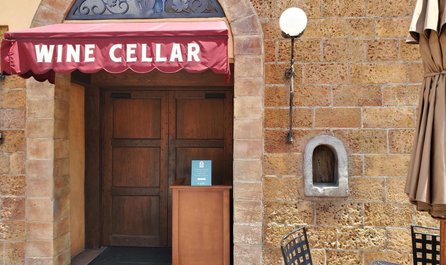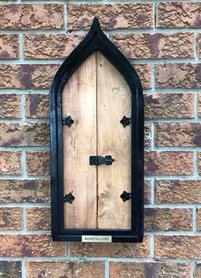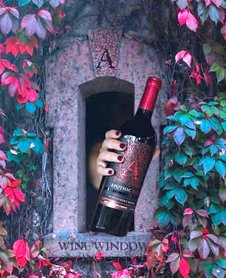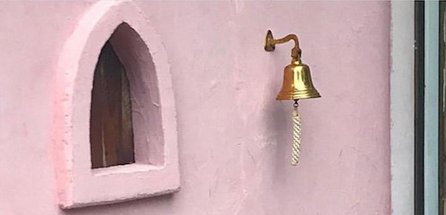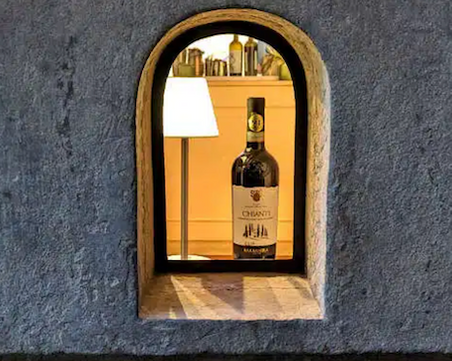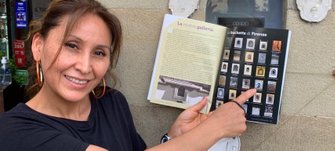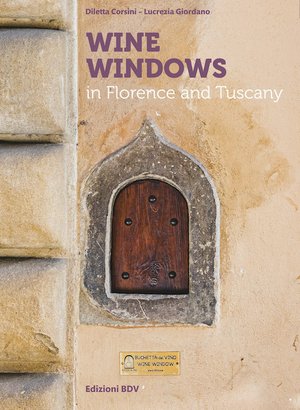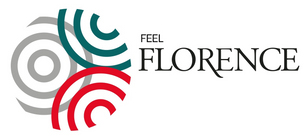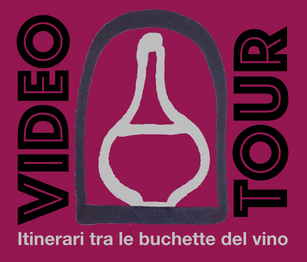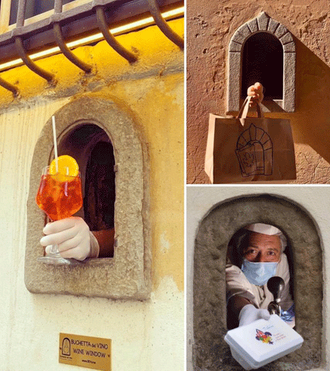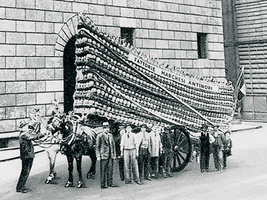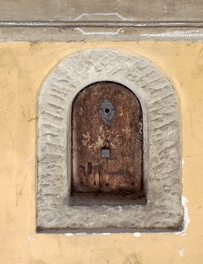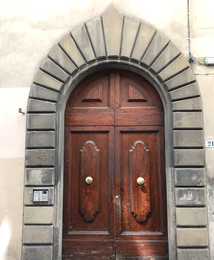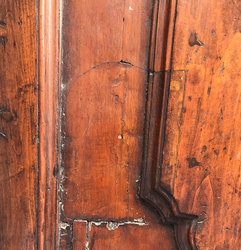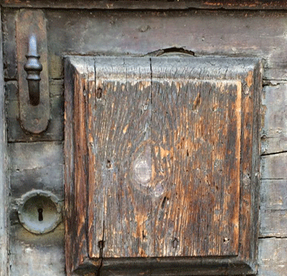Wine Windows Buchette del Vino
a Cultural Association in Florence
What are wine windows?
Wine windows are small arched openings in private homes where the owners sold the wine from their own vineyards directly to clients. They were normally carved out of the façade of the home and had a stone frame but sometimes they were carved out of the large wooden doors of the palace.
They often had a small door with a knocker. A client could knock on the door of the wine window and request that his bottle be filled. The wine windows were individually made and no two are exactly alike. They are of similar dimension, however, about 20 x 30 cm, large enough to accommodate a small wine bottle.
When where they first used?
The powerful Medici dynasty returned to power in Florence in 1532 and allowed wealthy landowners to sell their own wine directly to customers through the wine windows. The wine windows were still in occasional use as late as the early 1900s, meaning they had been in use for four centuries for the retail sale of millions of bottles of wine.
Where are they?
Wine windows can be found primarily in Florence, but also in other cities and towns of Tuscany. They are primarily located next to the main front door of large palaces of wealthy land-owning families, and were often connected directly with a storage area or cellar. They are usually at eye level to facilitate the transaction, although a few are located at foot level, with direct access to the wine cellar.
How many are there?
We have counted more than 180 wine windows in the Metropolitan city of Florence (158 of these are in the historical center). More than 100 wine windows are located in 30 other localities in Tuscany. These are unique architectural features which do not exist in any other place in the world.
Recently reopened
Recently some bars and restaurants reopened their wine windows in Florence and serve customers a glass of wine through the opening.
You can find all the addresses at the page "List & Maps".
EVERYBODY WANTS ONE!
New (and fake) wine windows around the world
Many people who have read about on the web or seen wine windows during a visit to Florence have decided to construct one for themselves or their friends in their own homes. Or, they create a wine window in a tavern or restaurant to use to dispense glasses of wine, as happens in Florence.
This article shows photos of some of the new wine windows which have appeared around the world.
NEW YORK Brooklyn
Epcot, Florida, USA
Kingston, Ontario, CANADA
California, USA
Williamsburg, New York, USA
Buenos Aires, ARGENTINA (Estados Unidos 470, San Telmo)
BRASIL
PHUKET, Thailand
Tampa, Florida, USA
Los Angeles, California, USA
Vancouver, CANADA
ARGENTINA
A GUIDE TO THE UNIQUE
WINE WINDOWS OF FLORENCE
An article by Rosemary Kimani and Claire Rouger, co-founders of "Authentic Food Quest", with all the information you need about the history of these tiny windows with wooden shutters and the reopened wine windows yuo can find in the historic center.
Enjoy.
THE BOOK
A beautiful book containing the history and most recent discoveries about wine windows in Florence and Tuscany is now on sale.
Written by art historians Diletta Corsini and Lucrezia Giordano, this is the definitive guide to information about the wine windows which are particular to Tuscany.
The book is full of illustrations and contains photographs of all 300 wine windows known up to now by our Association.
AVAILABLE ON AMAZON
It's possible to buy the book on Amazon, that prints and mails any order around the wold.
Here is the link:
and in some florentine bookstores
If you are in Florence, you can find the book in the following bookstores:
Paperback Exchange via delle Oche 4r
Libraccio via de' Cerretani 16r
CuriosaMente via dei Servi 94r
Salvemini Piazza Salvemini 18
Cento Libri via Pietrapiana 1
Libreria Gioberti via Gioberti 37 / via D'Antiochia 15
A tour of Unusual Florence
Video Tour is a project that the Wine Windows Association carried out in the month of February 2021 as part of a competition promoted by the Tourism Board of the City of Florence called UNUSUAL FLORENCE (Firenze Insolita) aimed at an Italian and global audience.
We produced four different, original video tours showing some of the many wine windows in the city of Florence and its outskirts to illustrate this small world which is overflowing with history, curiosities, and surprises.
We conducted seven guided tours of downtown Florence, one of which was on bikes, with the participation of 130 people. Each tour was different from the others, and we looked at dozens of wine windows, and recounted their history, emphasizing their deep social roots and value over the centuries. We explored their architectural beauty, as well as that of the streets, palaces and other monuments in the city of Florence.
We are grateful to the City of Florence for having made this project possible through its financial contribution, and we believe this is an important milestone in our ongoing research on the origins and uses of the wine windows in Tuscany.
March 8, 2021
Watch the VIDEOS subtitled in English
WINE WINDOWS
in the coolest district of Florence
WINE WINDOWS
on the hills around Florence
The strangest
WINE WINDOWS
in Florence
The Whole World is Talking about Wine Windows
During Italy’s nationwide corona virus lockdown, the Vivoli ice cream parlor in Florence came up with the brilliant idea of selling coffee, drinks and ice cream through their own wine window starting in May. This anti-contagion method of dispensing food and beverages was an immediate success and was copied by three other restaurants in Florence: Babae in Via Santo Spirito, the Osteria delle Brache in Piazza Peruzzi, and Il Latini in Via dei Palchetti.
During the same period, Diletta Corsini, our in-house art historian, found an amazing document from 1634 which talked about the use of the wine windows during the Black Death or bubonic plague in Florence. Even though people did not understand the transmission method of the bubonic plague in the 1600s, they wanted to avoid contagion and so the wine windows, which were already in use normally, became particularly useful for germ-free commercial transactions. This story was picked up by La Repubblica online and other Italian papers. Then the English journalist, Phoebe Hunt, interviewed Matteo Faglia, president of the Associazione Buchette del Vino, and wrote an article for Business Insider. This article was picked up by the New York Post and then by dozens of other newspapers, websites, and blogs around the world.
During August the news about the reopening of some wine windows in Florence circled the globe. Our Association and its website, Instagram and Facebook page were inundated by requests for information, photographs and interviews. Radio interviews of our members, and TV reports by the American CBS channel and English BBC World followed. In the month of August hundreds of articles and videos appeared around the world. We have tried to catalog all of those and post them on this website. Enjoy!
September 2, 2020
The feature for
BUSINESS INSIDER
ANTIGERM WINE WINDOWS
Yesterday and Today
Year 2020: The covid-19 pandemic arrives. Italy is under lockdown starting March 8th. Everyone is confined to home for two months and then the government permits a gradual reopening. During this time, some enterprising Florentine Wine Window owners have turned back the clock and are using their Wine Windows to dispense glasses of wine, cups of coffee, drinks, sandwiches and ice cream—all germ-free, contactless!
Year 1634: The Black Death or Plague has passed through the city of Florence, leaving death and havoc in its wake. The Florentine scholar, Francesco Rondinelli, writes a report about disease contagion and describes the use of the abundant Wine Windows in the city for the safe sale of wine, without direct contact between client and seller. Diletta Corsini describes this important document regarding Wine Windows and their uses almost 400 years ago.
Florence: the last Wine Window
by Diletta Corsini (translation Corinna Carrara)
The curved façade of the large yellow building set between Via Torta, Via dell’Anguillara and Via delle Burella, marked by two enormous lion heads at the main door offers us the view of a seemingly well-preserved ancient Wine Window from the outside.
Indeed, that little stone framed door positioned, as usual, under one of the windows next to the main entrance was (until proven otherwise) the last ‘active’ Wine Window of Florence.
A pleasant chat with the Marquis Bernardo
Gondi (who was born and lived his
adolescence in this building on Via Torta)
answered some questions that we had long
been waiting for. Namely, when did the Wine
Windows stop functioning and above all why
have they all been abandoned?
The Marquis’ childhood memories dwell
initially on that cart laden with wine barrels
drawn by oxen and occasionally horses that
every week, up until 1958, arrived from the
countryside into the city. The wine for retail
sale from the Wine Windows would not arrive
in demijohns but in special fifty-litre transport barrels.
The carts still had wooden wheels (it was a real sight watching them being made by the artisans, who would soak the oak staves for a long time in water to season and harden them) and with unpaved roads the risk of breaking the glass containers was very high.
At the time the Gondi
Marquis already had flasked
wine arriving from their
countryside estate, as vintners
and restauranteurs preferred
it that way; in this case the
fragile containers were tied
together with straw and
stacked into a pyramidal
form on the cart. This scenic
means of transportation
known as the ‘Crazy Cart’.
But back to our Wine Window, what’s behind it?
The Wine Window on the building, which used to belong to the Butini family, then the Ugolini before being purchased by the Gondi family in the 18thcentury.
It was eventually sold off to the National Employee Welfare Institute of Public Administration (now known as INPS), occupying one of two entrance rooms. The first room originally served as the Gatekeeper’s dwelling, who was called Beppino; the second room housed the barrels and demijohns.
Bernardo Gondi recalled that when the buyers knocked at the wooden door Beppino would open the Wine Window take the client’s flask, fill it up and receive payment. After which he would return the filled flask! Nothing other than wine would enter or leave that small Wine Window, apart from the occasional bottle of fine olive oil from the Val di Sieve farms.
The precious oil would arrive in small thirty-litre barrels, different to those produce for wine, as they had thick banded staves.
It was not really necessary to open
the Wine Window in order to receive
parcels and packages as Palazzo
Gondi door always remained open;
so, deliveries could easily be made
to Beppino through the large palace
gate which prevented free access
into the entrance hall.
As time went past the Wine
Window on Via Torta fell out of use.
The reason for this was the direct
competition from the nearby trader
who began selling bulk wine in his
shop close to the palace.
This ready-bottled wholesale wine
was far simpler than taking a flask
along to the Wine Window, especially as now plastic containers could be used, and clients tended to prefer cheaper less refined wine.
Furthermore, the end of sharecropping greatly influenced production costs in Tuscan wineries and finally the 1966 flood made these ground floor canteens inoperable for a long time.
These are the reasons why the Wine Windows fell out of use, no law decreed their demise, but rather the changing times and tendencies.
December 10, 2019.
The Granduke's Wine by Laura Baldini
The English writer John Evelyn in his diary of 1644 refer to a singular fact regarding the Granduke Ferdinando II de’ Medici – a meticulous and fascinating account of the events that go from 1640 to 1706. The leftover wine was sold off by the Granduke in the palace cellars; and even had straw-covered bottles hanging from the main vault of Palazzo Pitti for this purpose.
This seems somewhat absurd, not because of wine selling, but rather for the habit of hanging straw-covered wine flasks from the main entrance; an obligatory passageway for whoever wanted an audience with the Granduke.
August 10, 2019
Chronicle
from
Pitti
Palace
Another one in Borgo degli Albizi
Ricciardo Artusi, scholar of Florentine history, is an expert at finding wine windows, especially those which are embedded in the ancient wooden doors of Florentine palaces. Two years ago, (as noted in our Diary of 2016 on this website), he noticed the image of a wine window beneath a thick layer of paint in the main door of the famous Palazzo Medici Riccardi. He has now discovered another, in Borgo degli Albizi, 21, in the entrance door of a palace which carries the family crest of the Albizis. That makes the sixth wine window discovered in this ancient Roman street, equal to the number appearing in Via Santo Spirito.
There are now 146 wine windows in the historic center of Florence, but we hope that others will be discovered in the future.
July 15, 2019
A Well-Hidden Wine Window by Diletta Corsini
At first I wanted to entitle this article “The Houses of the Spirits”, after the famous book by Isabel Allende, a well-known storyteller. The reason was that the search for wine windows often results in mysterious coincidences and serendipity, leading one to think about the playful intervention of supernatural beings. For example, the last two wine windows we discovered were both carved out of the shutter of the front door and hidden by subsequent restoration. It is understandable that the most visible wine windows have already been noted and counted. Those which are less visible remain to be discovered. The amazing thing is that the two most recent discoveries were in buildings in piazzas of the same name but in different cities: Piazza Santo Spirito in Pistoia and in Florence.
The newest discovery in Florence is in the Guadagni Palace, situated at the corner of Piazza Santo Spirito, the most well known of the piazzas on the “left bank” of the Arno in Florence. The Guadagni Palace contains a beautiful porch constructed with horizontal beams which served as a model for many Florentine palaces. This magnificent Renaissance palace, constructed in the early 1500s for the Dei family and decorated by Andrea del Sarto, remained in the possession of wealthy gold merchants until 1683. It was then left to Buonomini di San Martino who sold it to the Guadagni family, whose crest it bears, and then was inherited by Dufour Berte in 1837.
To discover the wine window it is necessary to turn the corner to the side of the palace on Via Mazzetta, n. 10, the old entrance of the “Thouar”, which was perhaps the first public library of the city. On this door you can see a small, covered opening, as shown in the photograph. Behind the small door, at the top, you can see an arch which is the remains of a wine window which has been closed up. The dimensions and height of the opening demonstrate that this was a window used for selling wine to the public. Unfortunately also the internal part of the door has been modified, the small shutter has been sealed up and painted. Only a ghost of the antique wine window of the Guadagni Palace remains.
Who is Lady Morgan,
and why is she saying those
terrible things about us?
by Corinna Carrara
Lady Sydney Morgan (1783 - 1859) was one of the most controversial Irish authors of her time due to her diary/book "Italy", published in 1821, in the wake of her successful novels.
Along with her husband, Lady Morgan went on a Grand Tour commissioned by her editor, Colburn, whowanted to publish the impressions seen and described by her. "Italy" recounts just that, the disastrous political, economical and social situation in that country: causing heated diatribes and...
The Prince of Vintners by Diletta Corsini
The direct sale of wine from small windows in the noble palaces of Florence must have appeared to foreign visitors on the Grand Tour as a very singular characteristic of our city.
Not only the brilliant Lady Morgan (see the following article by Corinna Carrara), but also other English writers passing through Florence, have remarked upon the wine windows. Tobias Smollet said, shortly before the arrival of Pietro Leopoldo, that although Florence was densely populated, it seemed that there was very little commerce of any type.














